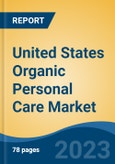Speak directly to the analyst to clarify any post sales queries you may have.
10% Free customizationThis report comes with 10% free customization, enabling you to add data that meets your specific business needs.
Consumers are increasingly seeking eco-friendly, cruelty-free, and ethically produced personal care items, particularly in the skincare segment, which accounts for over 40% of the market. The demand is driven largely by women, who represent more than 70% of the consumer base, and who are shifting towards products that are gentle, transparent in labeling, and aligned with clean beauty standards. This trend extends across skincare, haircare, cosmetics, and oral care, reflecting a broader lifestyle shift toward healthier and more conscious consumption.
Key Market Drivers
Rising Consumer Awareness and Health Consciousness
An increasing number of consumers in the U.S. are opting for organic personal care products due to heightened awareness of the potential health risks associated with synthetic ingredients such as parabens, sulfates, phthalates, and artificial fragrances. This shift is particularly strong among millennials and Gen Z consumers, who value clean beauty and ethical sourcing.These consumers are actively seeking transparency in product labeling and are influenced by the accessibility of information online and through social media. The growing demand for non-toxic, plant-based formulations is not limited to skincare but spans across haircare, oral care, and cosmetics, further expanding the reach of the organic personal care segment. The emphasis on wellness and environmental consciousness continues to drive consumer choices, making this a strong growth factor for the market.
Key Market Challenges
High Product Cost and Price Sensitivity
One of the major challenges facing the U.S. organic personal care market is the relatively high cost of products due to premium ingredient sourcing, sustainable packaging, and compliance with certification standards. These elevated production expenses result in higher retail prices, limiting access for price-sensitive consumers. Economic pressures such as inflation and rising living costs can further deter mainstream adoption, pushing some consumers to opt for conventional or "clean-label" alternatives that may not be fully organic but are more affordable. Additionally, the market faces competition from traditional brands introducing lower-cost “natural” variants that do not always meet rigorous organic standards. Without clear communication of the value and benefits, organic brands may struggle to justify their premium positioning to a wider audience.Key Market Trends
Personalized and Tech-Driven Skincare Solutions
The demand for personalization is reshaping the organic personal care landscape in the U.S., with consumers gravitating toward products tailored to their individual skin concerns and lifestyle factors. Advances in biotechnology, AI, and data analytics are enabling brands to offer customized skincare regimens through mobile apps, AI diagnostics, and at-home testing kits. Innovations such as DNA-based skincare and wearable tech devices are providing consumers with highly targeted and effective organic solutions. This tech-driven personalization is enhancing consumer trust, driving loyalty, and aligning with the values of efficacy and transparency. As consumers prioritize products that meet specific needs and deliver visible results, tech-enabled customization is expected to play an increasingly pivotal role in the evolution of the organic personal care market.Key Players Profiled in this United States Organic Personal Care Market Report
- L'Oreal USA, Inc.
- The Hain Celestial Group, Inc.
- Aubrey Organics, Inc.
- Eminence Organic Skin Care
- L'Occitane, Inc.
- Shea Terra Organics, LLC
- Orgaid Inc.
- Botanical Organic Products, LLC
- Radico USA, Inc.
- FarmHouse Fresh
Report Scope:
In this report, the United States Organic Personal Care Market has been segmented into the following categories, in addition to the industry trends which have also been detailed below:United States Organic Personal Care Market, by Product Type:
- Skin Care
- Hair Care
- Oral Care
- Others
United States Organic Personal Care Market, by Sales Channel:
- Hypermarket/Supermarket
- Specialty Stores
- Online
- Others
United States Organic Personal Care Market, by Region:
- South
- West
- Midwest
- Northeast
Competitive Landscape
Company Profiles: Detailed analysis of the major companies present in the United States Organic Personal Care Market.Available Customizations:
With the given market data, the publisher offers customizations according to a company's specific needs. The following customization options are available for the report.Company Information
- Detailed analysis and profiling of additional market players (up to five).
This product will be delivered within 1-3 business days.
Table of Contents
Companies Mentioned
The leading companies profiled in this United States Organic Personal Care market report include:- L'Oreal USA, Inc.
- The Hain Celestial Group, Inc.
- Aubrey Organics, Inc.
- Eminence Organic Skin Care
- L'Occitane, Inc.
- Shea Terra Organics, LLC
- Orgaid Inc.
- Botanical Organic Products, LLC
- Radico USA, Inc.
- FarmHouse Fresh
Table Information
| Report Attribute | Details |
|---|---|
| No. of Pages | 81 |
| Published | May 2025 |
| Forecast Period | 2024 - 2030 |
| Estimated Market Value ( USD | $ 3.01 Billion |
| Forecasted Market Value ( USD | $ 5.1 Billion |
| Compound Annual Growth Rate | 9.2% |
| Regions Covered | United States |
| No. of Companies Mentioned | 11 |









